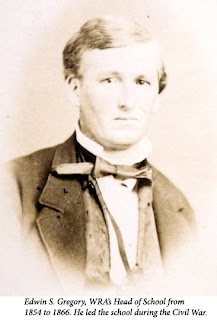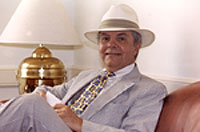 Since this is the year when Ohioans will either re-elect our incumbent Governor, or elect a successor, I thought it might be of interest to look at the now-forgotten career of the one WRA alumnus who was twice elected Governor of Ohio.
Since this is the year when Ohioans will either re-elect our incumbent Governor, or elect a successor, I thought it might be of interest to look at the now-forgotten career of the one WRA alumnus who was twice elected Governor of Ohio.George Kilbon Nash, born in 1842 in York Township in Medina County, grew up on a farm and came to Western Reserve Academy in 1859 during the era when Edwin S. Gregory was Principal of the school, and stayed for two years, enrolling in Oberlin College but dropping out in 1864 in order to enlist in the 150TH Ohio Volunteer Infantry. He served during the final year of the Civil War, after which he moved to Columbus, studied law, and was admitted to the Ohio bar in 1867. He served in the Secretary of State's office as a clerk, then was elected Franklin County prosecutor on the Republican ticket.
During the 1880's he served as Attorney General of Ohio during the two terms of Governor  Charles Foster, and became associated with the wing of the Republican party dominated by Marcus Hanna (who had been expelled from our school in the 1850's), William McKinley, and U. S. Senator John Sherman. He became Chairman of the Republican Party in Ohio in 1897, and two years later was elected the 41st Governor of the Buckeye State. He took office in 1900, was re-elected for a second term in 1901, and served until 1904.
Charles Foster, and became associated with the wing of the Republican party dominated by Marcus Hanna (who had been expelled from our school in the 1850's), William McKinley, and U. S. Senator John Sherman. He became Chairman of the Republican Party in Ohio in 1897, and two years later was elected the 41st Governor of the Buckeye State. He took office in 1900, was re-elected for a second term in 1901, and served until 1904.
 Charles Foster, and became associated with the wing of the Republican party dominated by Marcus Hanna (who had been expelled from our school in the 1850's), William McKinley, and U. S. Senator John Sherman. He became Chairman of the Republican Party in Ohio in 1897, and two years later was elected the 41st Governor of the Buckeye State. He took office in 1900, was re-elected for a second term in 1901, and served until 1904.
Charles Foster, and became associated with the wing of the Republican party dominated by Marcus Hanna (who had been expelled from our school in the 1850's), William McKinley, and U. S. Senator John Sherman. He became Chairman of the Republican Party in Ohio in 1897, and two years later was elected the 41st Governor of the Buckeye State. He took office in 1900, was re-elected for a second term in 1901, and served until 1904. One of the most notable events during Governor Nash's administration occurred in May, 1901 when the battleship Ohio was launched on San Francisco Bay. A huge ceremony was held on the dock with President William McKinley on hand to make a dedication speech, and Governor Nash and his niece, Helen Deshler, christening the ship with a bottle of California champagne. The battleship Ohio went on to become the flagship of the Pacific Fleet, and remained in service until 1922. This happy event proved to be one of the last ceremonial events attended by President McKinley who would be assassinated in Buffalo a few months later.
 The major event of Nash's years as Governor was the celebration of Ohio's centennial, marking 100 years since the state was admitted to the union. In his capacity as chief executive, Nash had appointed a Centennial Commission in 1901 of which he was Honorary Chairman, and he was the principal speaker at the big centennial celebration in Chillicothe, the original capital city of Ohio. The Governor also spoke at numerous centennial observances around the state. His accomplishments during those four years included the realignment of the state's taxation policy that led to a substantial reduction of the property tax. He also instituted the requirement that state agencies be regularly audited, and it was during his tenure that the legislature gave the governor his first authority to veto legislation. When he left office in 1904, Nash was praised as a hard working executive who had done much to advance the state.
The major event of Nash's years as Governor was the celebration of Ohio's centennial, marking 100 years since the state was admitted to the union. In his capacity as chief executive, Nash had appointed a Centennial Commission in 1901 of which he was Honorary Chairman, and he was the principal speaker at the big centennial celebration in Chillicothe, the original capital city of Ohio. The Governor also spoke at numerous centennial observances around the state. His accomplishments during those four years included the realignment of the state's taxation policy that led to a substantial reduction of the property tax. He also instituted the requirement that state agencies be regularly audited, and it was during his tenure that the legislature gave the governor his first authority to veto legislation. When he left office in 1904, Nash was praised as a hard working executive who had done much to advance the state. It was too bad that his old  school, Western Reserve Academy, did not seem to realize that an alumnus of the school was serving as Governor at the very time that Principal Charles T. Hickok was faced with the prospect of having to close the school. Perhaps it wouldn't have made much difference, but having a friend in high office might have persuaded the school's creditors and forestalled the closing of our doors in 1903, at the very moment when the state was extolling its centennial. Nash himself, a widower whose only daughter had also passed away, survived only a few months after he left office, dying in October, 1904.
school, Western Reserve Academy, did not seem to realize that an alumnus of the school was serving as Governor at the very time that Principal Charles T. Hickok was faced with the prospect of having to close the school. Perhaps it wouldn't have made much difference, but having a friend in high office might have persuaded the school's creditors and forestalled the closing of our doors in 1903, at the very moment when the state was extolling its centennial. Nash himself, a widower whose only daughter had also passed away, survived only a few months after he left office, dying in October, 1904.
 school, Western Reserve Academy, did not seem to realize that an alumnus of the school was serving as Governor at the very time that Principal Charles T. Hickok was faced with the prospect of having to close the school. Perhaps it wouldn't have made much difference, but having a friend in high office might have persuaded the school's creditors and forestalled the closing of our doors in 1903, at the very moment when the state was extolling its centennial. Nash himself, a widower whose only daughter had also passed away, survived only a few months after he left office, dying in October, 1904.
school, Western Reserve Academy, did not seem to realize that an alumnus of the school was serving as Governor at the very time that Principal Charles T. Hickok was faced with the prospect of having to close the school. Perhaps it wouldn't have made much difference, but having a friend in high office might have persuaded the school's creditors and forestalled the closing of our doors in 1903, at the very moment when the state was extolling its centennial. Nash himself, a widower whose only daughter had also passed away, survived only a few months after he left office, dying in October, 1904. Editor's note: This blog post is Tom Vince's 50th posting. Thank you all for your continued positive feedback concerning Western Reserve Academy's history. You are welcome to contact Tom at vincet@wra.net with story ideas and questions about WRA's history.
